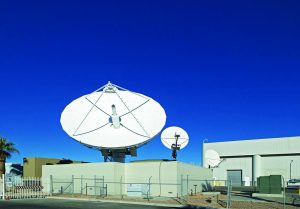 Back in 2002, the demand for bandwidth increased steadily especially for applications such as mobile telephony and SMS services. Nowadays, mobile communications and applications, with internet “everywhere” and entertainment “on-the-move” have become incredibly popular.
Back in 2002, the demand for bandwidth increased steadily especially for applications such as mobile telephony and SMS services. Nowadays, mobile communications and applications, with internet “everywhere” and entertainment “on-the-move” have become incredibly popular.
The reason for this increased demand is the proliferation of the use of mobile communication devices such as smartphones, tablets and laptops, which allows data to be consumed in any location.
According to Hisham Ansari, EVP, Horizonsat, “whereas many of the major metropolitan areas are covered with terrestrial mobile networks such as GSM (Global System for Mobile Communication) and RAN (Radio Access Network), millions of people in growing rural areas have limited or no access to cellular services.
“These markets are mainly in the Middle East and fast developing African countries, India and Asia. With increasing communication needs predominantly in rural areas, satellite backhaul can be used to extend terrestrial GSM networks. With satellite backhaul mobile telecom providers can extend their 2G, 3G, 4G and LTE or WIFI/WiMax networks.”
Ahmed Almuhaideb, VP of broadcasting and IPTV services at Du says: “Through VSAT we can reach any location on earth, more importantly remote sites, where establishing a fibre or microwave link requires a large investment. VSAT is also an ideal solution for ships and airplanes. Another application for satellite transport is the secure connectivity thru a single or a double hop satellite link versus the high probability of interruption through long fibre hauls.
“In recent years we’ve become used to experiencing slow internet because of fibre cuts in different regions in the world. Satellite can be a safer alternative for especially, critical services. The advantage of ubiquitous reach is countered by the economics. VSAT is not always the ideal solution cost wise, especially when fibre and microwave links are accessible. Another disadvantage of VSAT is the delay or latency of circuits for applications where two way high speed data is a requirement.”
Jean-Philippe Gillet, VP of EMEA Sales at Intelsat says: “The advantages of providing backhaul services via satellite-enabled VSAT are that the service is universally available regardless of terrain limitations or available equipment. It can be able to be deployed quickly, enabling faster expansion of services into rural areas, and certain high-powered services can be deployed using solar power, expanding their reach into far greater settings than fibre.”
Typical services enabled by satellite backhaul include rural cell backhaul services and international trunking services for mobile operators.
Several industries have found VSAT as being an effective means to serve their business requirements. Some of these are: Oil & Gas Field developers; Military, Security, Emergency services; Airlines; Telecom operators expanding their networks to remote locations; and banks with ATMs and branches serving remote communities.
Almuhaideb says: “The majority of du’s customers of VSAT services come from these industries. Du offers a range of services thru VSATs within and outside the boundaries of UAE and we’re seeing a growth in the demand of our VSAT services. The growth is despite the fact that the telecom networks in UAE are highly advanced and that now fibre reach is made to some of the most remote locations. This is because of the UAE’s rapidly growing economy and development.
“For example, the UAE enjoys one of the highest smartphone penetration rates in the world – pushing telecom operators to expand their 3G and 4G coverage to the edges of their service areas. Infrastructure development continues to be growing at a high pace all over UAE. Our VSAT services are now being used for Mobile Network backhauling; Oil & Gas Fields are one of our most important sectors, and we’ve used VSAT to transport TV video to terrestrial transmitter sites.”
With technology improving, costs for VSAT applications and backhaul are reducing. Gillet says HTS is one of these technologies that will result in cost savings. “Intelsat is evolving its network with the development of Intelsat EpicNG, our high-performance, next-generation satellite platform. Epic is more efficient than traditional satellites, delivering more throughput per MHz of spectrum. This platform will integrate seamlessly with our existing infrastructure, adding high-throughput satellite (HTS) services for customers. By building an open-architecture HTS platform that features a backward-compatible design, Intelsat EpicNG will deliver the lowest total cost of ownership for customers. This increase in throughput and the lower overall costs will allow wireless operators to expand services to less populated regions.”
Cost efficiencies were achieved through advancements in technologies. Most of VSAT costs are operational for leasing a certain bandwidth of the spectrum on the satellite. Hence, the developments were mainly targeted at reduction of the bandwidth requirement explains Almuhaideb. “Compression technologies, in voice and video, have brought in huge dividends in spectrum savings. Additionally, new solutions were introduced by some manufacturers. These solutions are used for specific applications; e.g. a solution to reduce bandwidth on satellites in order to transport voice services for mobile networks; another compression solution utilised video for broadcasters; there are solutions which are used to set up a network via satellites for a relatively high number of sites. These solutions are branded by solution owners and well known service providers.”
Ansari says: “Evolving technology allows teleports to cover the growth in satellite backhaul better, by using effective satellites with strong coverage, top-of-the-line equipment using latest technology with best possible modulation such as DVB-S2 or extended DVB-S2X, ACM option (Adaptive Coding and Modulation) – in order to maximise throughput regardless of link conditions.
“For non-symmetrical 3G and mobile broadband service a point-to-multipoint topology is the best solution where the downlink traffic to the different remotes can be mulitplexed aerially and temporarily taking advantage of the burst of such networks. For symmetrical satellite links SCPC with modern Forward Error Correction (FEC) techniques, such as VersaFEC, can be used as it enables further optimisation and reduction of power requirements. The optimisation of bandwidth and power leads to a reduction in satellite backhaul costs, especially for space segment, BUC power costs and also energy saving.”
Besides satellite backhaul there are different terrestrial backhaul options such as DVB-T, DVB-T2 for TV, DVB-RCS (cable TV), fibre connections and RAN networks with new and effective BTS towers which can serve 3G and 4G mobile communication generation. The decision of what to use is a commercial decision and a question of regional availability.
So what’s next on the Horizon? Almuhaideb says that there has been great development in increasing the throughput via a satellite network. High Throughput Satellite (HTS) systems combine the exceptional spectrum efficiency and performance of spot-beam antennas with ultra-wideband transponders to enable unprecedented levels of bandwidth and throughput. “The advent of high-throughput satellites enables network service providers to offer a new generation of communications solutions. Perhaps this is the current trend and the future outlook is towards achieving more efficient and higher speeds delivered via satellite networks,” adds Almuhaideb
According to Ansari, “The current generation of wireless communications technology is 3G which allows telco operators to offer wireless data services to clients in any location. The mobile phone becomes the primary communication device which will increase the demand for cellular backhaul demand from subscribers. Therefore, the deployment of 3G mobile broadband in remote areas will happen faster than initially anticipated, driven by the device market and the user.
“The next generation of wireless techniques will be with 4G. Applications such as entertainment and TV on the move will become more and more popular, which will boost the demand for satellite backhaul. To cover this increasing demand the satellites – as seen in the past – will become more powerful and will have more capacity. At the same time antenna size will decrease and more effective compression and modulation technology will be offered from satellite equipment manufacturers,” concludes Ansari.












Add Comment